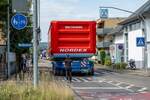News Release from WindEurope
Wind Industry Profile of
It’s official: The EU Commission wants 30 GW a year of new wind up to 2030
Last year the EU increased its greenhouse gas emissions reduction target for 2030 from 40% to 55%. Today the European Commission tabled legislative changes to enable the EU to reach this new target. The so-called “Fit-for-55″ package contains changes to over 10 pieces of legislation, including the Renewable Energy Directive, the Energy Tax Directive, the Alternative Fuels Infrastructure Directive and the EU Emissions Trading System.
The Commission proposal raises the EU’s renewable energy target from 32% to 40% by 2030. This means the EU will need 451 GW of wind power capacity by 2030, up from 180 GW today. This means the EU will need to install 30 GW of new wind farms every year between now and 2030 – a major acceleration in the expansion of wind energy. As it stands, we expect to build only 15 GW a year over 2021-25.
“The Fit-for-55 package sends a clear message to consumers and investors. The EU wants a major expansion in renewables by 2030, with nearly twice as much new wind as we’re currently building. And the EU wants to accelerate the electrification of those sectors that have so far relied on fossil fuels. This is good for the climate. And good for the economy. The Fit-for-55 package means major new investments. It’s a package for jobs and growth”, says WindEurope CEO Giles Dickson.
The revision of the EU Renewable Energy Directive crucially improves the legal framework for corporate Power Purchase Agreements (PPAs). Member States would have to issue Guarantees of Origin (GOs) for all renewable electricity, regardless of whether the producer was awarded support in government auctions. This will improve the traceability of renewable electricity. To further incentivise electrification, the package includes indicative annual renewables targets for industry; the share of renewables in industry should increas by 1.1% annually.
“The package will trigger additional demand from industry and other big energy consumers who want to source renewables directly. Energy-intensive companies are knocking on our door wanting us to help them decarbonise. And this will only increase”, says Dickson.
The new Renewable Energy Directive will also help the development of offshore wind including hybrid offshore wind farms that have multiple grid connections. The proposal would require EU countries to jointly plan their offshore wind build-out in each sea basin.
The new Energy Tax Directive sets out new rules for the taxation of electricity and energy products used in transport and heating. It removes subsidies for fossil fuels and has helpful provisions to reduce the risk of double taxation for electricity storage. The Directive also proposes that national tax systems should rank fuels according to their energy content and environmental performance, so that the most polluting fuels are taxed the most. The new Energy Tax Directive will need unanimous support from national Governments.
The Fit-for-55 package adjusts the EU Emission Trading System (ETS) to the new climate ambition by further reducing the number of tradeable allowances. It extends the scope of the ETS by bringing in the shipping sector and by establishing a separate ETS for emissions from the buildings and road transport sectors. This will increase the price for carbon emissions and further incentivise investments in renewables-based electrification. A new Social Fund will channel 25% of the revenues from the new EU ETS on mobility and heating to those citizens that are disproportionally affected.
“The transition of the power sector is in full swing. Now we need to decarbonise the rest of the energy system. The EU ETS revision will give new price signals to support investments in the electrification of heating and transport. And the new Social Fund will ensure that this is a just and inclusive transition”, says Giles Dickson.
To create a level playing field between domestic and imported products and reduce the risk of companies transferring their production to countries with lower CO2 standards (carbon leakage), the Fit-for-55 package includes a new Carbon Border Adjustment Mechanism. This will put a carbon price on imports of steel, cement, aluminium, fertilizers and power. The wind industry will follow this closely to ensure it avoids undermining its global supply chains of essential materials and components.
The Fit-for-55 package further reinforces the role of electrification in transport. It includes more stringent CO2 emissions standards, a ban to the sales of diesel and petrol cars by 2035 and a new target for charging stations along highways; one every 60 km. The revised Alternative Fuels Infrastructure Directive includes targets for electric charging infrastructure for light and heavy-duty vehicles and electrification targets for certain ships. The package also says that renewable fuels of non-biological origin, such as renewable hydrogen, must be 2.6% of total transport energy consumption by 2030.
The main hurdle to a rapid expansion of wind energy in Europe remains: complex rules and procedures for permitting new wind farms. WindEurope calls on the European Commission to work with Member States to help them simplify their permitting rules and procedures.
Giles Dickson says: “The Commission wants wind to be half of Europe’s electricity by 2050 and wants over twice as much wind capacity in 2030 as we have today. This is perfectly feasible from the point of view of technology and finance. But it needs a major improvement in the permitting procedures for new wind farms across Europe. The EU has a key role to play here in identifying and promoting best practice.”
The various legislative proposals that make up the “Fit-for-55 package” now have to be negotiated and agreed by the 27 EU Member States and the European Parliament.
- Source:
- WindEurope
- Author:
- Press Office
- Link:
- windeurope.org/...
- Keywords:
- WindEurope, EU Commission, Europe, Fit for 55, package, renewable energy, wind power, decarbonisation, CO2 emissions, climate chage, reduction, target, rules

























